Monastic Island of Reichenau: The Island of Reichenau is located on Lake Constance, the lake is situated on the border between Austria, Germany and Switzerland. The island is reachable via a causeway. The Island of Reichenau preserves the traces of a Benedictine monastery. Abbott Pirmin founded the monastery in 724. The monastery developed between 800 and 1100 into an important cultural and spiritual centre of the Holy Roman Empire. The Monastery of Reichenau housed a scriptorium, a school and artists' workshops. The Plan of St. Gall, a precious ground plan and the earliest-known architectural plan drawn on parchment, was made in a scriptorium on the Monastic Island of Reichenau around 820. The three churches on the Monastic Island of Reichenau are good examples of the architecture of the early Middle Ages in Central Europe. The Romanesque Minster of St. Maria and St. Mark in Mittelzell is the largest church on the island, it is the original centre of the Monastery of Reichenau. The twin-towered St. Peter and St. Paul in Niederzell is a former abbey church. The St. George Church in Oberzell is considered one of the best examples of the Carolingian architecture, the murals in the St. George Church are briljant examples of the Ottonian period. The well preserved murals fill the entire nave of the church. The murals are among the oldest in Europe north of the Alps and show the importance of Reichenau as an artistic centre during the 10th and 11th centuries. Illuminated manuscripts from the Ottonian period (between 919 and 1024) produced in the Monastery of Reichenau (Lake Constance) are inscribed on the UNESCO Memory of the World Register. The manuscripts are housed in the Bayerische Staatsbibliothek in München. The Monastic Island of Reichenau gained the status as a UNESCO World Heritage in 2000.
www.werelderfgoedfotos.nl © Copyright World Heritage Photos
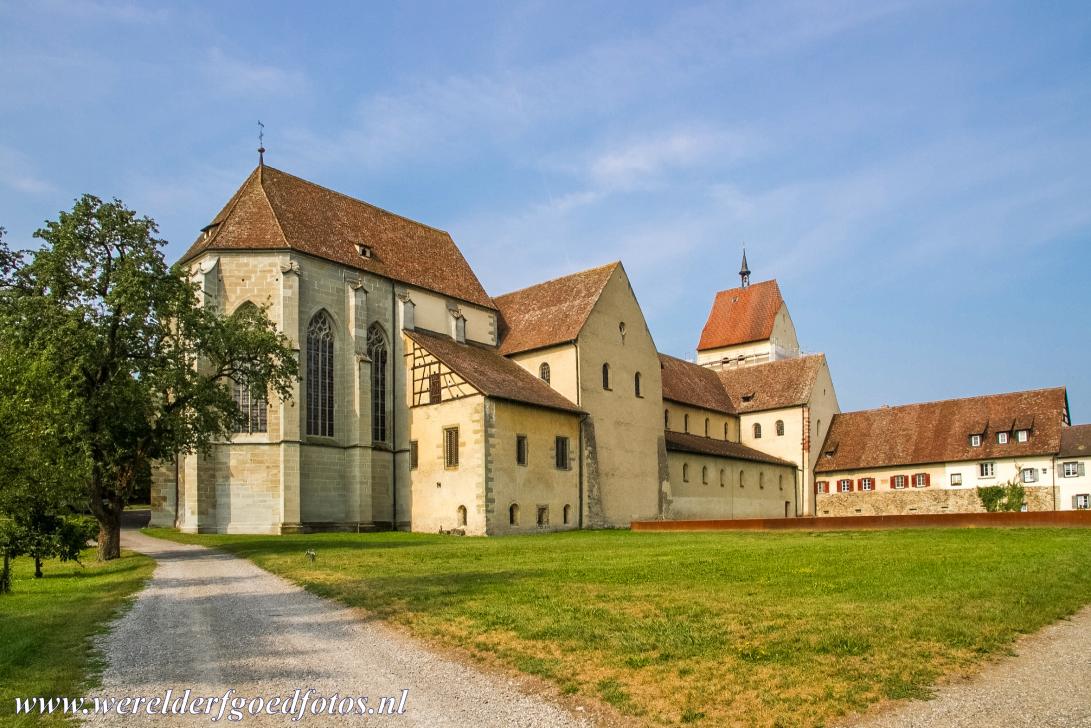
Monastic Island of Reichenau: The Minster of St. Maria and St. Mark in Mittelzell. In 724 AD, the Abbot Pirmin founded the Benedictine Monastery of Reichenau on Reichenau Island. Reichenau was an important religious and cultural centre in medieval Europe. Under Charlemagne and his son Ludwig the Pious, the monastic island experienced its 'Golden Age'. Between 800 and 1100, Reichenau developed into a cultural and spiritual centre of the Holy Roman Empire.

Monastic Island of Reichenau: The Minster of St. Maria and St. Mark in Mittelzell. In 724 AD, the Abbot Pirmin founded the Benedictine Monastery of Reichenau on Reichenau Island. Reichenau was an important religious and cultural centre in medieval Europe. Under Charlemagne and his son Ludwig the Pious, the monastic island experienced its 'Golden Age'. Between 800 and 1100, Reichenau developed into a cultural and spiritual centre of the Holy Roman Empire.
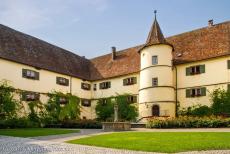
Monastic Island of Reichenau: The former building of the Benedictine Monastery of Reichenau. The monastery itself was dissolved in 1803. Nowadays, the building serves as the town hall for the district of Reichenau and the cellar is used by the winegrowers of Reichenau to store wine. Illuminated manuscripts from the Ottonian period produced in a scriptorium of the Monastery of Reichenau on Lake Constance were inscribed on the UNESCO Memory of the World Register.
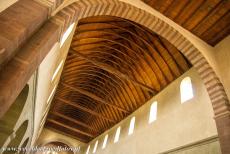
Monastic Island of Reichenau: The Minster of St. Maria and St. Mark in Mittelzell, the form of the arcades of the nave goes back to the 12th century. The wooden roof in the shape of an upside-down ship was constructed in 1236. The Romanesque Minster of St. Maria and St. Mark stands in the small village of Mittelzell and is the largest church on the island, the church is the original centre of the former Benedictine Monastery of Reichenau.
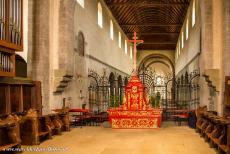
Monastic Island of Reichenau: The Minster of St. Maria and St. Mark in Mittelzell. The Monastery of Reichenau housed a school, a scriptorium and several artists' workshops. The Plan of St. Gall, the earliest-known architectural plan drawn on parchment, was created in a scriptorium on the Monastic Island of Reichenau in Germany. The precious Plan of St. Gall is now preserved in the library of the Abbey of Saint Gall in Switzerland.
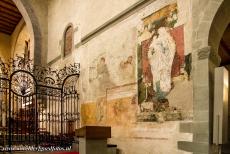
Monastic Island of Reichenau: A mural on the north wall in the Minster of St. Maria and St. Mark in Mittelzell. After a fire in 1006, the church was carefully restored between 1008 and 1048. The three Romanesque churches on the Island of Reichenau houses numerous amazing murals, the murals are among the oldest in Europe north of the Alps. During the Carolingian period and up to the 13th century, the Monastic Island of Reichenau was a major centre of learning.
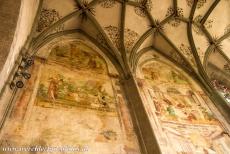
Monastic Island of Reichenau: The murals in the Minster of St. Maria and St. Mark in Mittelzell. During the Carolingian and Ottonian periods, the Monastery of Reichenau was regarded as an intellectual outpost of the Western World. The murals in the churches on the Monastic Island of Reichenau bear witness to the importance of Reichenau as a cultural centre during the 10th and 11th centuries. Monastic Island of Reichenau was declared a UNESCO World Heritage in 2000.
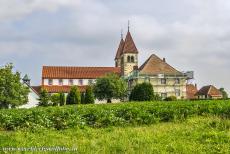
Monastic Island of Reichenau: The St. Peter and St. Paul Church in Niederzell is second oldest church on the Monastic Island of Reichenau. The church was founded by the former bishop of Verona and consecrated in 799, after the demolition of this church, the present church was built in the 11th century, partly on the old foundations. Nowadays, the twin-towered St. Peter and St. Paul Church is the Catholic parish church of the village of Niederzell.
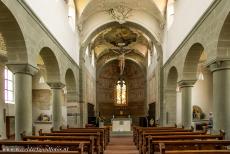
Monastic Island of Reichenau: The Church of St. Peter and St. Paul in Niederzell was completely redesigned in the Rococo style around 1750. The medieval mural in the apse from the period between 1104 and 1134 is still visible, the Romanesque mural was discovered in 1900, it shows several biblical figures, such as Christ in Majesty surrounded by the twelve apostles, the symbols of the archangels, Christian prophets and St. Peter and St. Paul.
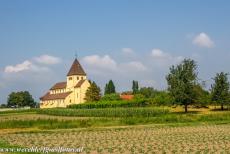
Monastic Island of Reichenau: St. George Church in Oberzell is surrounded by vegetable fields and and orchards. The St. George Church was built in the 9th century and is renowned for its Ottonian murals. The Monastic Island of Reichenau is located on Lake Constance on the three-country border between Austria, Germany and Switzerland. The island is easily reachable via a causeway that runs through the Wollmatinger Ried Nature Reserve, a wetland and bird area.
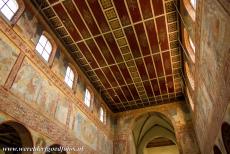
Monastic Island of Reichenau: The St. George Church in Oberzell is considered one of the best examples of the Carolingian architecture. The murals in the St. George Church are magnificent examples of the Ottonian period. The well preserved murals fill the entire nave of the church, most of them are up to two meter high and four meter wide. The murals are among the oldest in Europe north of the Alps.
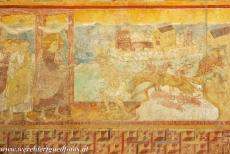
Monastic Island of Reichenau: This Ottonian mural in the St. George Church in Oberzell depicts the story of the Bible: The Healing of the Demon Possessed Man from Gerasa. The murals in the nave of the church are the largest connected cycle of monumental murals from around the year 1000 in Europe north of the Alps. The eight murals in the St. George Church depict the miracles performed by Christ.
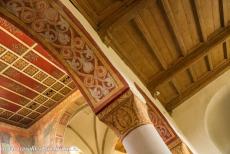
Monastic Island of Reichenau: The fine decorated column capitals and arcades of the St. George Church in Oberzell. The Ottonian murals in the nave of the St. George Church in Oberzell are the oldest medieval murals in Germany, the murals were made at the end of the 10th century. They were discovered underneath thick layers of white wash in 1856, the murals are closely related to the illuminated manuscripts created in the Monastery of Reichenau.
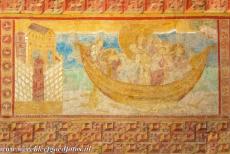
Monastic Island of Reichenau: This Ottonian mural in the St. George Church in Oberzell depicts: The Calming of the Windstorm on the Sea of Galilee. The large Ottonian murals in the St. George Church illustrate the miracles performed by Christ. To protect the more than thousand years old Ottonian murals, the St. George Church in Oberzell is only accessible from April to October, the church can only be visited on a guided tour.
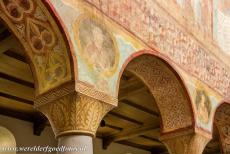
Monastic Island of Reichenau: The St. George Church in Oberzell, even the column capitals of the church are decorated with murals. The UNESCO World Heritage consists of three churches on the Island of Reichenau: The Minster of St. Maria and St. Mark in Mittelzell, the St. Peter and St. Paul in Niederzell and St. George Church in Oberzell. The Monastic Island of Reichenau was inscribed on the UNESCO World Heritage List in 2000.
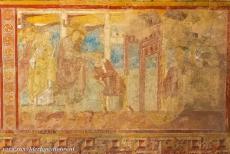
Monastic Island of Reichenau: The eight large murals in the St. George Church in Oberzell depict the miracles performed by Christ. This Ottonian mural in the St. George Church inillustrate: The Healing of the Man Born Blind. Most of the murals are up to two metres high and four metres wide. The murals show the importance of the Monastic Island of Reichenau as an artistic centre during the 10th and 11th centuries.
